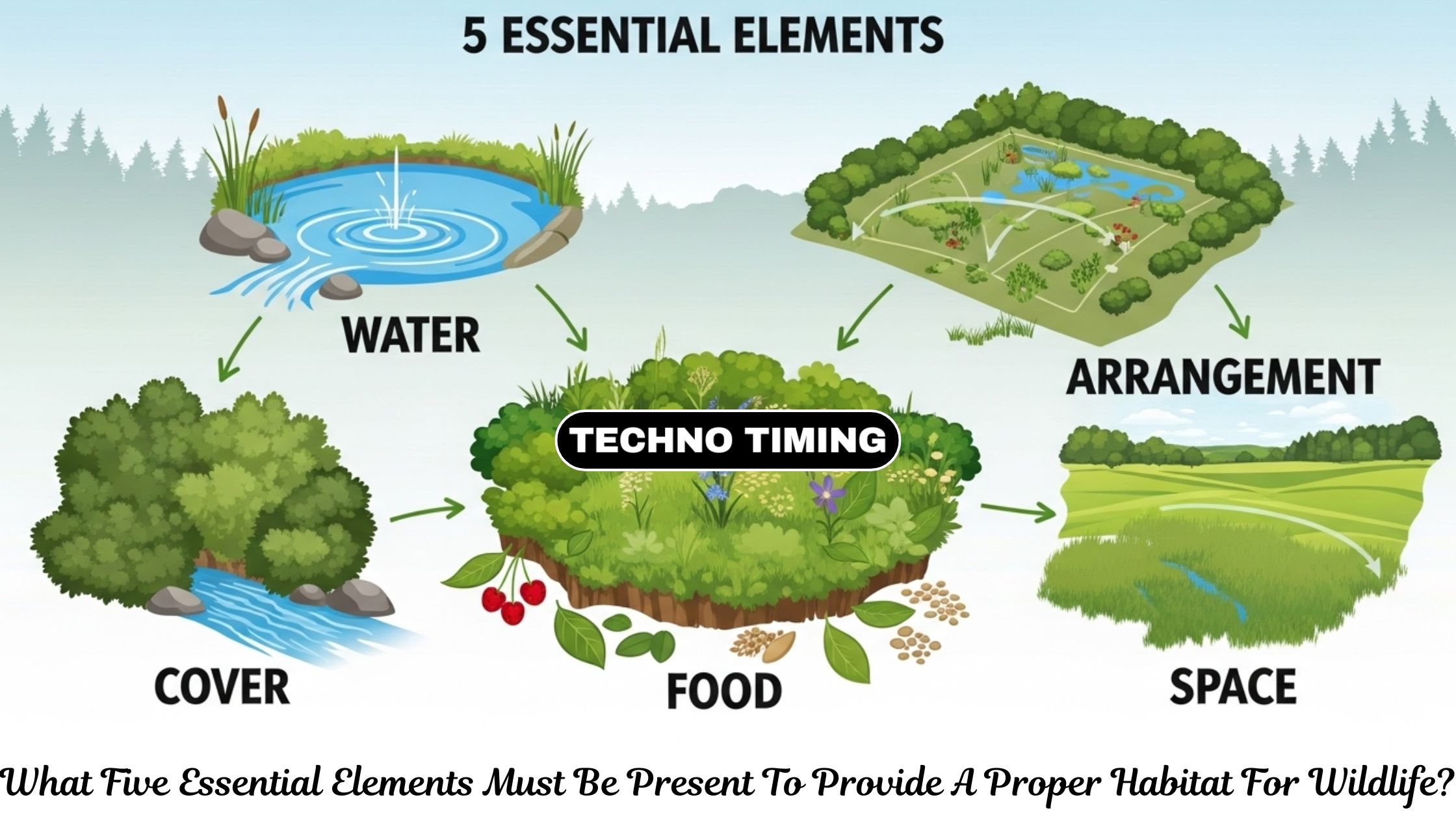The 5 Essential Elements of a Wildlife Habitat Explained
The 5 Essential Elements for a Proper Wildlife Habitat: A vibrant ecosystem depends on the health and stability of its wildlife populations. But for wildlife to flourish, their environment must provide for all their basic needs. A proper habitat is more than just a place to live; it’s a carefully balanced system that offers everything an animal needs to survive, reproduce, and thrive.
Understanding the core components of a healthy habitat is the first step in effective wildlife conservation. When these elements are present and correctly balanced, they create the foundation for biodiversity. This article will explore the five essential elements that every wildlife habitat must have to support its inhabitants.
What Are the 5 Essential Elements of a Wildlife Habitat?
For any animal to survive, its environment must provide five key components. The absence of even one of these can significantly impact a species’ ability to maintain a healthy population. These five essential elements are food, water, cover, space, and arrangement. Let’s look at each one in more detail.
1. Food
The most obvious requirement for any living creature is a reliable food source. Food provides the energy needed for growth, reproduction, and daily activities. The dietary needs of wildlife are incredibly diverse, and a healthy habitat must cater to them.
- Herbivores, like deer and rabbits, need access to a variety of plants, grasses, and fruits.
- Carnivores, such as wolves or hawks, depend on a steady population of prey animals.
- Omnivores, like bears and raccoons, consume both plants and animals.
The availability of food often changes with the seasons. A resilient habitat must offer a consistent food supply year-round or provide resources that animals can store. A balanced food chain is critical; a healthy plant population supports herbivores, which in turn feed carnivores, creating a stable ecosystem.
2. Water
Water is fundamental to all life. Animals need clean, accessible water for drinking, bathing, and, in many cases, reproduction. The presence of a consistent water source is a critical factor that determines where wildlife can live.
Water sources in a habitat can include rivers, lakes, streams, ponds, and even temporary puddles. Different species have different needs. While a large lake is essential for fish and amphibians, a small puddle can be a vital resource for insects and birds. The quality of the water is just as important as its availability. Polluted water can be toxic to wildlife, disrupting the entire ecosystem. Beyond hydration, water also helps animals regulate their body temperature, like when an elephant cools off in a river.
3. Cover
Cover refers to the shelter that protects animals from predators and harsh weather conditions. It provides a safe place for wildlife to rest, breed, nest, and raise their young. Without adequate cover, animals are vulnerable and exposed.
Cover can take many forms, from natural features like dense brush, tall grasses, and tree hollows to rock piles and caves. For many species, cover is essential for raising the next generation. Birds need safe branches for nests, while many mammals require dens or burrows to protect their young. The type of cover needed can also vary by season. For example, a bear needs a den for winter hibernation, while a deer may seek shade under trees during the hot summer months.
4. Space
Every animal needs a certain amount of space to live and thrive. Space helps prevent overcrowding, which can lead to intense competition for resources like food and mates. When animals are too crowded, stress levels can rise, and diseases can spread more easily.
The amount of space an animal needs, often called its home range or territory, varies greatly between species. Large predators, like mountain lions, may require vast territories to find enough food, while a small rodent might live its entire life within a single acre. For migratory species like monarch butterflies or wildebeest, space includes the corridors they use to travel between different habitats during seasonal changes.
5. Arrangement
The final, crucial element is the arrangement of the other four components. It’s not enough for a habitat to have food, water, cover, and space; these resources must be arranged in a way that is accessible and useful for the wildlife living there.
The ideal arrangement allows animals to meet all their needs within a relatively small area, minimizing the energy they have to expend and the risks they have to take. For example, a water source located far from any cover makes an animal vulnerable to predators every time it needs a drink.
Many animals thrive in areas where different types of habitats meet, a phenomenon known as the edge effect. The boundary between a forest and a grassland, for instance, offers access to the resources of both ecosystems. River bottoms are another prime example, providing water, cover from riverside vegetation, and a variety of food sources all in one corridor.
Creating a Better Home for Wildlife
Understanding the five essential elements of a habitat—food, water, cover, space, and arrangement—is fundamental to wildlife conservation. The loss or degradation of any one of these components can have a ripple effect, threatening the stability of entire ecosystems.
By focusing on protecting and restoring these key elements, we can help ensure that wildlife populations have the resources they need to thrive for generations to come. Whether in a national park or your own backyard, providing these five components is the key to supporting a healthy and vibrant natural world.
Frequently Asked Questions (FAQ)
What are the five essential elements of wildlife habitat?
Those elements are food, water, cover, space, and proper arrangement/placement so animals can easily access them.
Why is arrangement important in habitat design?
Arrangement ensures animals don’t have to travel dangerously long distances to meet basic needs. Well‑placed resources reduce stress, energy use, and vulnerability to predators.
What roles do native plants play in food and cover?
Native plants support higher biodiversity—they offer the right kinds of food (nectar, seeds, insects) and cover tailored to local wildlife. Diverse native vegetation layers (ground, shrub, canopy) create micro‑habitats for a wide variety of species.
What about nesting or baby-rearing in wildlife habitats?
A proper habitat offers safe, sheltered spaces—like thickets, brush piles, hollow logs, or nest boxes—for raising young. This ties back into “cover” and part of functional arrangement.
What is the most important element for wildlife survival?
While all five are essential, many biologists argue that habitat itself (which includes all these elements) is the single most important factor. If an animal loses its home, it loses everything—its food, its water, its safety. The quality and availability of a proper habitat are fundamental.
Why are these five elements crucial for a proper habitat?
These five elements—food, water, cover, space, and arrangement—are the absolute basics that every single species needs to survive, reproduce, and maintain a healthy population over time. Lacking even one of these can cause a population to decline or disappear from an area entirely.
How do the five essential elements create a balanced ecosystem?
They work together to support the entire web of life. Plentiful food and water support a variety of species. Good cover allows prey animals to hide, ensuring they don’t get wiped out, which in turn sustains the predator population. Adequate space and proper arrangement ensure that all these interactions can happen naturally without stressing the environment. It’s a beautiful, self-regulating system.
What Are the Five Basic Habitat Requirements for Wildlife?
The five basics are food, water, cover, space, and arrangement. They ensure animals have everything needed to survive and thrive.
What Makes a Good Habitat for Animals?
A good habitat balances the five essentials in a way that’s accessible and sustainable. It supports diverse species without overuse, like a well-arranged forest edge near a stream.
How Can I Improve Wildlife Habitat on My Property?
Start small: Plant natives for food and cover, add water features, and leave space undisturbed. Focus on arrangement by clustering resources.
What Is the Edge Effect in Wildlife Habitats?
It’s the boost in biodiversity where two habitats meet, offering more food and cover options—like shrubland blending into grassland.
Why Is Space Important in Wildlife Habitats?
Space reduces competition and stress, allowing room for mating, nesting, and movement without overcrowding.
Are There Any Other Elements Needed for Wildlife?
While the five are core, factors like climate and human impact play roles, but they build on these basics.
What are the 4 basic needs of wildlife?
Often, you might hear about four basic needs: food, water, cover, and space. The concept of “Arrangement” is a more advanced but essential ecological principle that explains how the other four must be configured to create a truly viable habitat. So, while the first four are the physical components, the fifth is the spatial relationship that makes them work.
What is the most important element of a habitat?
This is a trick question! All five elements are equally important. A habitat is like a chain, and it’s only as strong as its weakest link. An area with abundant food and cover but no water cannot support life. Similarly, an area with all the resources but a poor arrangement will be a dangerous place for animals to live. They are all interconnected and interdependent.
What is carrying capacity?
Carrying capacity is the maximum number of a specific species that a habitat can support indefinitely without degrading the environment. It’s determined by the availability of the five essential elements for wildlife habitat. If a population exceeds the carrying capacity, it can lead to starvation, disease, and damage to the habitat itself.
How can I create a wildlife habitat in my backyard?
You can apply these same principles on a smaller scale!
Food: Plant native flowers, shrubs, and trees that produce seeds, berries, and nectar.
Water: Add a birdbath or a small pond.
Cover: Create a brush pile in a corner of your yard, plant dense shrubs, or let a section of your lawn grow wild.
Space & Arrangement: Even in a small yard, you can arrange these elements so a bird or butterfly can easily move from your feeder to your birdbath to the safety of a nearby shrub.
What happens if one of the five essential elements is missing?
When any of the five essential elements is absent or inadequate, the habitat becomes non-functional for most wildlife species. Animals either won’t establish themselves in the area or will struggle to survive if they do. This often leads to population declines and eventual local extinctions.
Can artificial features replace natural habitat elements?
While artificial features like bird feeders, nest boxes, and water features can supplement natural habitat, they cannot fully replace the complex interactions provided by natural ecosystems. The most effective approach combines natural habitat management with targeted artificial enhancements.
How much space do different wildlife species actually need?
Space requirements vary dramatically by species. Small songbirds might thrive in areas measured in acres, while large mammals like elk or bears require territories measured in square miles. The quality of available food, water, and cover also influences space requirements – higher quality habitat can support more animals in smaller areas.
Why is arrangement so important compared to the other elements?
Arrangement determines habitat efficiency. Even when food, water, cover, and space are abundant, poor arrangement forces wildlife to expend excessive energy traveling between resources. This energy could otherwise be used for survival, growth, and reproduction, making well-arranged habitat far more valuable than scattered resources.
Also Read: What is the Difference Between GA4 and Google Search Console (GSC)


